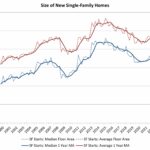If you’re wondering if now is a good time to buy a house, ask this instead: Is it a good time in my life to buy a house?
Housing market trends give important context, so we’ll look at those numbers here. But ultimately, whether this is a good time to buy a house depends on your financial situation, life goals and readiness to become a homeowner.
Let’s explore both aspects of the homebuying journey: the housing market and your own readiness to buy a home.
How’s the housing market right now?
These are some factors affecting buyers in today’s market.
Mortgage rates: At their lowest since February 2023
The interest rate on a 30-year fixed-rate mortgage averaged 6.28% annual percentage rate (APR) for the week ending Aug. 15, down one basis point from the previous week and down 90 basis points from a year ago, according to rates provided to NerdWallet by Zillow. A basis point is one one-hundredth of 1%.
Average weekly mortgage rates
Averages are for the week ending Aug. 15, 2024, according to rates provided to NerdWallet by Zillow.
Buyers got some welcome relief this month, when the 30-year fixed-rate mortgage dropped to its lowest average rate since February 2023. In general, mortgage rates have remained stubbornly high throughout the first half of 2024. If inflation gets under control later in 2024, as many experts predict, mortgage rates are likely to continue a modest decline.
Did you know…
Higher rates shrink buying power because they make home loans more expensive. For example: Let’s say you make a 20% down payment on a $350,000 house. With a 6.8% mortgage rate, your monthly payment would be $1,825 (not including home insurance and property taxes). With a 5% mortgage rate, the monthly payment would be $1,503 — $322 lower.
You can’t influence average rates, so focus on the things you can control:
Shop around for the best deal. Especially given today’s higher rates, buyers can save $600 to $1,200 per year by applying for loans from multiple mortgage lenders, according to a February 2023 study by Freddie Mac, the government-sponsored entity that buys conforming loans from mortgage lenders.
Lock in your rate. After getting approved for a home loan, consider locking in the mortgage rate until the loan closes to protect against further rate increases.
Mortgage loans from our partners
Mortgage loans from our partners
Inflation and the economy: Waiting for the Fed to cut rates
The Federal Reserve, the nation’s central bank, guides the economy with two goals: encouraging job growth and keeping inflation under control. The Fed doesn’t directly set mortgage rates. However, it does set the federal funds rate, which influences interest rates for loans including mortgages.
After a series of 11 increases to the federal funds rate in 2022-2023, the Fed has kept things steady since last September. A rate cut of even a fraction of a percentage point would offer buyers more relief.
With inflation slowly easing, the Fed could consider cutting rates at its next meeting on Sept. 17-18, 2024.
Supply of homes for sale: Still limited (but getting better)
A shortage of homes for sale has made this a tough era for buyers. But inventory is finally improving: In June, the months’ supply of homes for sale reached its highest level in more than four years.
In June, there was a 4.1-month supply of homes on the market nationwide, according to the National Association of Realtors (NAR), meaning it would take a little more than four months at the current pace for all the properties to sell. That’s an improvement over last month (3.7 months) and last year (3.1 months). The market hasn’t seen inventory above a four-month supply since May 2020, when supply was 4.5 months.
Did you know…
In a balanced market, the supply of homes for sale would last six months. Supply less than that is considered a seller’s market. More than a six-month supply is considered a buyer’s market.
“We’re seeing a slow shift from a seller’s market to a buyer’s market,” NAR Chief Economist Lawrence Yun said in a news release. “Homes are sitting on the market a bit longer, and sellers are receiving fewer offers. More buyers are insisting on home inspections and appraisals, and inventory is definitively rising on a national basis.”
Home prices: Higher than ever after a 12-month climb
The national median price for existing homes sold in June was $426,900, up 4.1% from June 2023, according to the NAR. That’s the highest median price ever recorded by NAR, beating last month’s record high and following 12 straight months of year-over-year price increases.
Under the crunch of high prices, sales of existing homes — properties that were owned and occupied before going on the market — dropped 5.4% from May to June, according to the NAR. Sales are also down 5.4% compared to June 2023, when the median existing-home sales price was about $410,000.
All four U.S. regions — Midwest, Northeast, South and West — saw year-over-year price increases in June. Here’s a regional look at median prices and year-over-year price changes:
Midwest: $327,100, up 5.5%.
Northeast: $521,500, up 9.7%.
South: $373,000, up 1.7%.
No one can predict exactly what the market will do next. But in a news release, Yun paints an optimistic picture that high prices might be topping out now that inventory is improving.
“Even as the median home price reached a new record high, further large accelerations are unlikely,” Yun said. “Supply and demand dynamics are nearing a balanced market condition. The month’s supply of inventory reached its highest level in more than four years.”
Competition: Steady, but less intense than last year
Some good news: Compared to last summer, competition has cooled off. The June 2024 Realtors Confidence Index, a survey of the NAR’s members, highlights these key market indicators year over year:
Houses for sale are getting fewer offers. A home listed for sale received an average 2.9 offers in June, down from 3.5 offers per home last year.
Fewer homes are selling above list price. In June, 29% of homes sold above listing price, down from 33% a year ago.
Homes are staying on the market longer. Houses stayed on the market for a median 22 days in June — four days longer than June 2023, when the median was 18 days. Last month, 65% of homes sold in less than a month. A year ago, that figure was 76%.
Overall, though, demand still outpaces supply. This is hardly a mellow market: Good homes sell quickly, and buyers should still expect competition out there. If you’re ready to buy, get a mortgage preapproval so you’re prepared to make a strong offer. Once mortgage rates drop, competition will only go up. There’s no time like the present to start shopping.
Homebuying readiness: Should I buy a house now or wait?
Ask yourself these questions to explore whether you’re ready to buy a home.
Are you prepared to put down roots?
Think about your life goals, relationships and interests. How long can you see yourself living in this location?
Ideally, you’d want to remain in the home long enough for rising property values and your equity to exceed the costs of buying and selling, including real estate commissions and mortgage closing costs. That will typically take several years.
You could also be subject to capital gains taxes if the home appreciates in value and you sell it after less than two years.
How’s your job security?
A mortgage is a big commitment and can become a stressful burden after a job loss, so it’s not a good time to buy a home if you think you’ll get laid off.
Wait until your employment is stable before thinking about buying a house.
Are you financially prepared?
Here are the three main ingredients to evaluate.
Savings
You’ll need money for a down payment and mortgage closing costs as well as for moving and other expenses after you buy the home. The down payment requirements vary by the type of mortgage and the lender. The more you put down, the lower your monthly mortgage payment.
The typical down payment for first-time buyers is 8% and for repeat buyers is 19%, according to an NAR survey of home buyers who purchased a primary residence from July 2022 through June 2023.
Credit
Lenders generally offer the best mortgage rates and terms to borrowers with credit scores of 740 and above, although you can qualify for a mortgage with a score in the 600s. The options are much slimmer, and loan costs can be higher for borrowers with a score in the 500s.
If your credit is marginal, it might make sense to postpone buying a house and use the time to work on building your credit.
The average FICO credit score for closed mortgage loans to purchase homes in the past 30 days was 735, according to mortgage data provider ICE Mortgage Technology.
Debt
Lenders look at your debt-to-income ratio (DTI) to help determine whether you qualify for a mortgage. Your DTI is the percentage of your monthly gross income that goes toward monthly debt payments, including housing costs, as well as car, student loan, credit card and other debt obligations. Lenders like to see a DTI under 36%, although it’s possible to qualify with a higher ratio. The lower your DTI, the better your chances of qualifying for a mortgage and getting offered the lowest available rate.
The average DTI for purchase mortgages in the past 30 days was 40%, according to ICE Mortgage Technology.
Mortgage loans from our partners
Mortgage loans from our partners
This article was originally published by a www.nerdwallet.com . Read the Original article here. .



